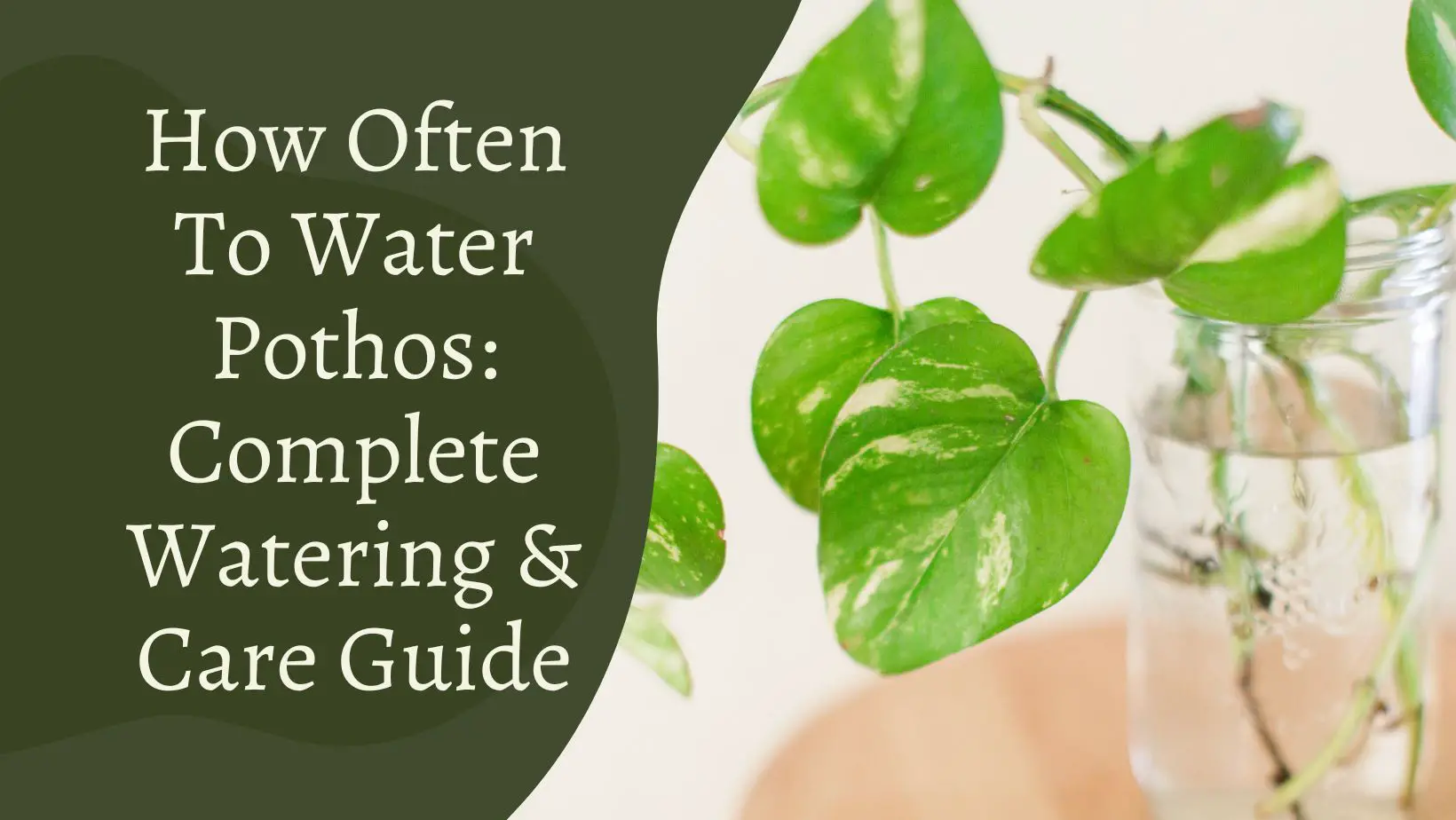
If You are wondering how often to water pothos then you come to right place this article is all about pothos watering and care. The pothos plant, also known as golden pothos, money plant, or devil’s ivy (Epipremnum aureum), pothos (Epipremnum aureum) is a hardy indoor foliage plant native to Southeast Asia in the arum family (Araceae).
It resembles the ordinary philodendron and is sometimes mistaken with it. Pothos plants are simple to cultivate and care for same like topped plants and they thrive in a range of interior environments. In other words, the plant can withstand a wide range of light, temperature, humidity, and watering conditions.
Furthermore, the pothos plant is one of the few indoor plant species that can thrive in the absence of natural light. In general, the pothos plant is a low-maintenance botanical addition to an interior environment. The pothos plant, often known as Devil’s Ivy, has waxy, smooth leaves. The leaves of the pothos plant come in a wide range of hues.
In the spring and summer, water pothos plants once every seven days, and once every ten to fourteen days in the winter. Allow the top inch of soil to dry out completely before watering your pothos plants again, and always soak them thoroughly. Once every seven days, mist the pothos leaves with water to produce a humid microclimate.

How often to water pothos indoors
Pothos is a plant native to Asia and Oceania’s warm tropical and subtropical climates, where it thrives in high humidity, protected from strong winds, and well-draining soil. Pothos is a versatile plant that can thrive in a range of environments, although it needs uniformly wet soil that dries out somewhat between watering sessions.
The leaves of the pothos might turn brown as an indication of drought stress if the potting soil dries up entirely for a lengthy period of time if the humidity is extremely low. Pothos leaves become yellow and droop if the soil is wet rather than simply moist, which might indicate root rot.
To correctly water pothos, it’s vital to mimic their native environment’s usual watering cycle and moisture levels in the potting soil. Before watering again, the top inch of the potting soil should be allowed to dry out. This way, the pothos will be able to get the water they need.
Water pothos plants once every seven days during active growth in the spring and summer, and once every ten days in the winter. Because houses tend to have low humidity, misting the leaves of a pothos plant indoors is often important, especially with air currents from air conditioning and sources of heat in the winter months.
Misting your pothos leaves once a week helps to counteract the drying effects of air currents and generates a humid micro-climate that mimics the tropical, forest habitat of the pothos. However, depending on your temperature and conditions.

There are various factors that might determine how often to water pothos:
- Your climate’s average humidity and temperature range.
- The pot’s or container’s size (smaller pots and containers faster then larger pots).
- When pothos is indoors, it is in the air current of air conditioning and close to heat sources.
- The potting soil’s ability to retain moisture.
Teel the top inch of the potting soil with your finger to detect the level of the soil’s wetness. This is the most reliable approach to determine how frequently to water pothos for your individual climate and circumstances in your home. If the soil appears damp, wait a few days before watering until it appears to be drying out, which is the ideal time to water with a deep soak.
How often to water pothos in winter
Even when grown indoors, the pothos plant’s requirement for hydration varies with the seasons. Pothos requires less watering in the winter since growth slows owing to fewer hours of daylight and decreased light intensity.
During the winter months, watering pothos once every 10 to 14 days covers the plant’s water needs and avoids any issues related with overwatering, such as root rot. However, the location of the pothos in the home is vital to consider since if it is near a source of heat or in the direction of forced air, the soil will dry up more rapidly.
The pothos should keep healthy and green throughout the winter if the top inch of the soil dries out between watering, and if give it a good bath and spritz the leaves once a week.
How often to water pothos in summer
Summer brings hotter days, which necessitates more regular watering. Pothos must make up for the amount of water lost due to evaporation. So, throughout the summer, water pothos 2 to 3 times a week. Unless pothos plant are in a really hot, low-humidity environment, the pothos plant should be alright. Summer is the best time of year to start sprouting new leaves.
Before watering, poke a finger or a wooden stick (skewer) into the soil to make sure it’s dry. If the first couple of inches are dry, it’s time to give pothos plant a drink. When a pothos is in its ideal conditions, which are warm, moist, and exposed to the brilliant summer sun, which is precisely what we get in the United States throughout the summer, it will grow swiftly.
The humidity rises on wet summer days, while the temperature drops. In this sort of weather, you might only need to water pothos once a week, so make sure to check the soil frequently.

How often to water golden pothos
The golden pothos is without a doubt the most popular cultivar. In comparison to the Marble Queen, this variant has more pronounced splotches of ivory or light yellow tint. Golden Pothos love slightly damp soil, so water them once or twice a week.
Water the plant several times each week throughout the hotter months to keep the soil wet and nutrient-absorbable. Although they thrive in damp soil, if golden pothos receives too much moisture, they will grow agitated and die. Between watering, a pothos plant like its soil to be entirely dry.
Types of pothos plant:
The most popular kind of pothos plant is Jade Pothos, which has green leaves that are equally pigmented. The leaves of the Golden Pothos are a patchwork of yellow pothos leaves and green colours. The leaves of the Marble Queen Pothos are spotted white and green.
The Neon Pothos is a newer kind of pothos with green and chartreuse leaves. A native of the Solomon Islands in the South Pacific, It is a 10 foot low-growing vine. It is better to cut the tendrils back when pothos is used as a hanging plant, rather than spread them out all over.. This will help the plant grow a thicker base.
Every leaf has a dry nub at the stem-vine junction. This nub will grow into a root if the pothos plant is near soil. Its tendrils may stretch downward if cultivated as a hanging plant. The leaf nubs will stay dry and short as the vine develops. Pothos cuttings are another simple method.
Finding the nub at the vine’s base and cutting below it is all it takes. Incorporate the nub, or many nubs, into the main plant cutting. Immerse the cutting in water to create a new pothos plant. This nub will soon become a root. After a week or two, place the cutting in soil and thoroughly water.
Beautiful indoor pothos plants purify the air. The Pothos plant is one of the most powerful air purifiers (NASA). Late 1980s study by NASA and Associated Landscape Contractors of America (ALCA). Indoor plants can remove hazardous pollutants like formaldehyde and benzene. One of the most efficient species for cleansing indoor air is the pothos plant.
Golden pothos light requirement:
Golden pothos plant prefers bright yet indirect sunshine for best development. 5-10 feet away from a south-facing window (closer to the inside of a room) or near a west-facing window is often the greatest spot for them. On any window sill where it’s not too close to be burned and not too far away to be in need of light, Pothos can grow.
To be a house plant, these tropical vines need a lot of light. They can handle dappled sunlight and indirect light. Pothos roam and weave along the tropical rainforest floor or up the trunks of trees and buildings in their natural environment. This means they are never in direct sunlight and can handle a fair amount of shade.
However, because pothos is still a plant, it must photosynthesize by exposing the green sections of its leaves to the sun in order to produce its own nourishment. Beginner pothos parents make the most common error by putting the plant in too much shadow or near-darkness. The end effect is frequently a sad, slow-growing pothos plant that has lost its lovely hue and is desperately snaking toward the sun.

How to make pothos fuller
There are a few simple things which can make pothos seem lush, healthy, and full.
Feed the Pothos:
Feed the Pothos With the Right Fertilizer Pothos doesn’t require much fertilizer under normal circumstances, as it derives all of its nutrients from the soil. Over time, the soil of the potted pothos depletes, and if the plant’s development is hindered, it’s time for a nitrogen boost.
Liquid seaweed, indoor plant food, and slow-release mild fertilizers are the best choices for pothos. For a pothos plant in need of some encouragement, applying fertilizer once a month should be more than enough. However, for a poor plant, this wouldn’t be enough, and feeding it bi-monthly would be preferable.
Examine the Soil’s Vitality
When it comes to pH levels, pothos isn’t fussy and can thrive in both neutral and acidic soils. Just make sure the soil doesn’t get alkaline, since it won’t be good for it. Because soil drainage is significantly more essential than soil pH, if the soil appears to be overly compacted, it will need to aerate. When water the plant, make sure the drainage holes in the container are clear.
There’s also the issue of chemical build-up to consider. Minerals, fertilizers, and pesticides have a tendency to build up in the soil. This might damage the plant by interfering with its nutrient-absorption processes. A good watering can sometimes wash away these excesses, but if the soil is excessively polluted, it’s preferable to replace it.
Finally, it’s a good idea to refill the old soil with organic compost or another indoor plant soil mix on a regular basis. This should help to revitalize the soil while also keeping the plant happy.

Determine Watering Schedule For How Often To Water Pothos:
The easiest way to water the pothos is to water it heavily until the water drains out of the drainage holes. After that, the plant should be left alone to absorb all of the liquid. You may examine the soil every other day and water it again after the top layer is dry.
It’s worth mentioning that the summer watering regimen is unlikely to be as effective in the winter. As a result, it’s recommended to use soil dryness as a major indicator of the plant’s watering requirements.
Place the Pothos in a Bright Area
A pothos should be placed next to a large window that faces west or southeast because pothos need light. The south is far too bright, while the north is far too dark. Overcrowding a pot could give it the same look. There would be a lot of sunlight on the leaves at the ends, but not much on the middle. The easiest way to avoid this is to keep the plant clipped and spread equally in the pot.
Pothos pruned on a regular basis
Cutting off the leaves that are weak, leggy, or dead encourages new development. This is one of the most effective methods for making the pothos fuller. Long stems are often seen hanging from pothos plants but they don’t add much to the plant’s fullness.
When the pothos is kept in a dark place, it grows in a “leggy” way. They do this because they don’t get enough light, so they make their stems longer. There is no need to remove all of these lanky stems. When you cut the pothos plants, you can start new plants. Simply plant the leaves in tiny pots with their nodes, or submerge them in water in glass containers.
Adjust the Temperature and Humidity
It is recommended that the temperature around the pothos be changed so that it doesn’t get too hot or too cold. Pothos requires a high level of humidity to thrive. It wouldn’t be fussy and want a precise humidity level, and life would be OK as long as its surroundings weren’t too dry.
That’s reasonable because this isn’t a cactus. It’s wonderful to mist the pothos now and then, and the plant typically appears revitalized after each rain. However, this does not provide a humid environment that can be sustained. It’s frequently a good idea to put a porcelain bowl next to the plant and fill it with water.
Defend Against Pests
Houseplants frequently have unpleasant experiences with common bugs and pests. The invasion is frequently undetectable at first. But after a few days or weeks, the plant begins to display apparent indications of illness. It’s much preferable to catch the bugs early on in their attack than to wait until they’ve done irrevocable damage. It can also help to use organic pesticides and home remedies to get rid of many pests.
How often to water pothos winter care
In the winter, the best approach to care for the pothos plant is to keep it warm. Pothos are tropical plants thus they must spend the winter in a warm climate. If you have an indoor pothos plant, keep it away from windows and chilly draughts throughout the winter.
It’s also vital not to repot your pothos in the winter months. Since they don’t appreciate too much disruption or change at this time of year too. In the winter, only use pots with drainage holes since pothos is extremely prone to root rot.
If you see that your pothos is suffering, you’ll need to trim the decaying roots and refill the soil with fresh potting mix. Pothos plants require a lot of sunshine in the summer, but they require indirect light in the winter since direct sunlight might burn them! So, for four or five hours each day, position your plant somewhere where it will receive brilliant filtered light.

Jade pothos care
The Araceae family includes Jade Pothos, which is native to Southeast Asia. The money tree, the jade vine, or the jade plant are all names for this plant. When people have special events like a wedding or a funeral, they use the leaves of this plant to make the events more special and beautiful. It is one of Singapore’s best-known symbols.
The jade pothos is popular because it is easy to grow, requires little water, and thrives in a variety of light situations. The jade pothos derives its name from the dark green color of its leaves, which have white streaks that resemble jades when held up to the light.
Soil
The jade pothos is a slow-growing plant that doesn’t need much light. The jade pothos thrives in soil that drains well yet maintains moisture, allowing it to keep producing lush new growths without withering or drying out. Top-dressing with high-quality potting soil and fertilizing with a balanced liquid fertilizer diluted to half the label strength works well for Jade Pothos plants.
Light
Because the jade pothos plant does not thrive in direct sunshine. Keep it away from any windows or other bright light sources that might cause leaf burn. If you’re going to grow jade pothos outside, make sure it’s in a shady spot with enough of room for the roots.
Watering
jade pothos plants watering when they become dry to keep them damp but not too wet. Watering jade pothos plants on a regular basis can prevent any leaves from browning between watering. If they are kept too dry for too long, that could happen.
Temperature
Warm temperatures are ideal for jade pothos plants. Keep jade pothos plants away from draughts and vents. Since this can cause browning of the leaf tips if the plant is too cold, or drying out at night if the plant is too close to a vent or open window with dry air. Jades can turn yellow if they don’t get enough warmth.
Humidity
Plants like Jade Pothos thrive in humid settings. In general, the jade pothos doesn’t care what kind of soil it grows in. But it does need a lot of water and must stay wet. Otherwise the leaves will rapidly dry out. When jade pothos aren’t getting enough water from the soil in the winter. A humidity tray might assist them keep their moisture levels up.
Hanging golden pothos. Place the hanging basket hook on the L-bracket arm or the screw hook. Slowly lower the basket to confirm that the hook or bracket can support the plant’s weight.
Conclusion:
The pothos plant is popular, especially when used indoors. In addition, the plant can naturally filter contaminants from the air. Pothos plants are nearly redundant since they are so simple to maintain. You’ll have them for years if you just water them when they start to appear wilted. However, if you want to provide the greatest possible care for them so that they are happy and healthy as possible

Hi This is Maria, We are a team of gardening enthusiasts with a passion for gardening. We have tried to bring you tips and advice enabling you to grow and maintain a healthy and beautiful garden. We Hope You Find it Useful.






